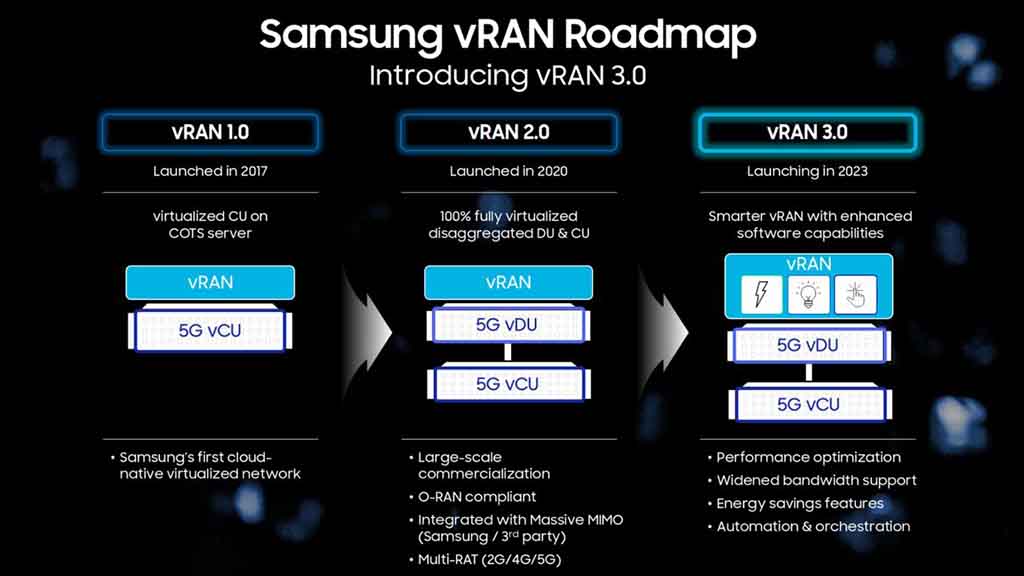News
Samsung 5G vRAN 3.0 with AI tools coming to North America

Today, Samsung introduced the new 5G vRAN 3.0 and confirmed that it’s planned to roll out in North America in the first half of 2023. The company wishes to make its next-generation virtual RAN capabilities to global operators, starting in America.
The South Korean tech giant has been contributing to the earliest massive commercial adoption of 5G virtualized networks across the world. Notably, it has been the only major vendor that has conducted large-scale commercial vRAN deployments with Tier One operators in America, Europe, and Asia.
As disclosed by Samsung, the new 5G vRAN 3.0 technology is packed with a range of new “smart” features as well as it’s optimized to address the needs of forward-looking operators. Through a graphical roadmap, the company also showcased its vRAN has proved the capabilities of smart networking.

Samsung’s vRAN 3.0 features advanced capabilities including increased bandwidth support of Massive MIMO radios, analyzing hourly traffic patterns to optimize network operating conditions, and automating networks with “sleep mode” to save energy consumption.
“While Samsung’s 5G vRAN has successfully proven its performance by delivering results on par with traditional hardware-based equipment in commercial networks, we are moving fast into the next phase of vRAN software development — Samsung’s vRAN 3.0,” said Ji-Yun Seol, Vice President, Head of Product Strategy, Networks Business at Samsung Electronics.
Samsung’s next-level vRAN capabilities include the following:
Performance Optimization
- 200MHz 3 Cell Support
With a software upgrade, Samsung’s vRAN will be equipped with the ability to provide 3 Cell configuration with 200MHz of bandwidth support using its 64T64R Massive MIMO radios.
- Modem Algorithm Optimization
Modem algorithm optimization enables operators to receive software tailored to their needs, with only the required features and configurations, allowing for an optimized and efficient use of COTS servers.
Power Savings
- CPU Core Sleep Mode
This feature reduces power consumption by automatically putting the CPU in “sleep mode” — or turning off unused CPU Cores — during periods of low data traffic.
- Adaptive Core Allocation
This feature of Samsung’s vRAN software assigns a number of CPU Cores at cell setup proportional to the number of active cells. Unassigned or unused CPU Cores are set to idle mode to reduce power consumption.
- Energy Saving Feature Orchestrator (ESFO)
ESFO automatically analyzes hourly traffic patterns and optimizes the operating conditions of each Energy Saving feature, per sector and time zone.
The tool constantly updates the multi-level Energy Saving operations of multiple power-saving features — such as cell on/off and Tx path on/off — to reflect traffic pattern changes and prior results.
News
Samsung and Arm partner on parallel processing for 6G

Samsung R&D wing partners with Arm on the research of parallel processing for 6G. Samsung’s leading research and development organization collaborating with semiconductor and software design company Arm to research parallel packet processing.
SIMD, known as Single Instruction Multiple Data, is one of the key software technologies in next-gen communications. Samsung Research and Arm plans to introduce an open-source project to develop and refine parallel processing for 6G.
“This technical partnership with Arm is a significant step towards revolutionizing parallel technology,” said Jinguk Jeong, Executive Vice President at Samsung Research’s Advanced Communications Research Center.
Arm also announced leveraging its expertise in high-performance, low-power and flexible computing by collaborating with Samsung Research to accelerate the 6G software development and enable the AI infrastructure to run as efficiently as possible.
Since SIMD processes vast quantities of communication data, Samsung Research’s work with Arm seeks to significantly accelerate the research and development timeline ahead of the surge of data driven by 6G environments.
Stay up-to-date on Samsung Galaxy, One UI & Tech Stuffs by following Sammy Fans on X/Twitter. You can also discover the latest news, polls, reviews, and new features for Samsung & Google Apps, Galaxy Phones, and the One UI/Android operating system.
Do you like this post? Kindly, let us know on X/Twitter: we love hearing your feedback! If you prefer using other social platforms besides X, follow/join us on Google News, Facebook, and Telegram.
News
Young Hyun Jun will lead Samsung’s semiconductor business
Young Hyun Jun will now lead Samsung’s semiconductor business. The company today revealed that it named Young Hyun Jun as the new Head of Device Solutions (DS) Division.
President Kyehyun Kyung, who has been leading the DS Division, will become the Head of the Future Business Division as well as the Head of Samsung Advanced Institute of Technology (SAIT).
Young Hyun Jun will focus on the DS Division and strengthen Samsung’s position amid an uncertain global business environment. Notably, Jun has extensive experience in the semiconductor and battery businesses.
Samsung hired Jun in 2000 for DRAM and Flash memory development. Later, he became Head of the Memory Business in 2014 and CEO of Samsung SDI in 2017, before leading the Future Business Division in 2024.
Stay up-to-date on Samsung Galaxy, One UI & Tech Stuffs by following Sammy Fans on X/Twitter. You can also discover the latest news, polls, reviews, and new features for Samsung & Google Apps, Galaxy Phones, and the One UI/Android operating system.
Do you like this post? Kindly, let us know on X/Twitter: we love hearing your feedback! If you prefer using other social platforms besides X, follow/join us on Google News, Facebook, and Telegram.
News
Android’s hot Circle to Search arriving on iOS

Circle to Search feature may be available on the iOS platform this year. In an exciting development, folks over at the Mac Observer discovered that Google is preparing to upgrade Chrome for iOS with Android’s awesome Circle to Search feature.
Chrome for iOS silently added a new “Lens Circle to Search” flag. When enabled, it will likely bring the feature to Apple’s iOS devices. Well, it is expected to be a Lens-powered feature available within the application itself, rather than system-wide integration.
Circle to Search debuted earlier this year with the Galaxy S24 series. It’s developed by Google for Galaxy and Pixel devices. As of now, a number of Samsung and Google devices have access to it. Meanwhile, the expansion may take place to more Android vendors and iOS too.
This feature is literally powered by Google Lens. Thanks to system-wide integration, it feels like a core feature of the Android operating system. Through an app update, Google seems to be planning Circle to Search beyond Android devices.
Stay up-to-date on Samsung Galaxy, One UI & Tech Stuffs by following Sammy Fans on X/Twitter. You can also discover the latest news, polls, reviews, and new features for Samsung & Google Apps, Galaxy Phones, and the One UI/Android operating system.
Do you like this post? Kindly, let us know on X/Twitter: we love hearing your feedback! If you prefer using other social platforms besides X, follow/join us on Google News, Facebook, and Telegram.












